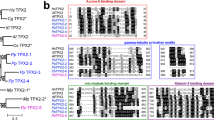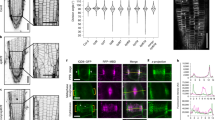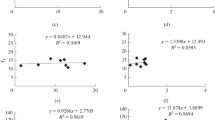Abstract.
The present work establishes a correlation between cell length and patterns of mitotic microtubular assemblies in Allium cepa L. root meristems. Binucleate cells were formed by a short caffeine treatment which aborted the formation of the phragmoplast during telophase. The largest binucleate cells (about 50 μm in length) behaved as two contiguous mononucleate cells in their next mitosis: they developed two preprophase bands (PPBs), one around each nucleus, where two spindles and two phragmoplasts were subsequently formed. On the other hand, the shortest binucleate cells (about 36 μm in length) formed a single PPB at the site of the aborted phragmoplast and, in the medium-sized cells (about 44 μm) in which the single PPB formed around the nucleus possessing the largest cytoplasmic environment, the two mitotic spindles and the new phragmoplasts moved to, or were assembled in the position of the phragmoplast that had been aborted one cycle earlier. Some rules derive from these observations. First of all, the aborted phragmoplast left a signal for microtubule positioning which was still operative one cycle later, in two-thirds of the bimitoses. Also, that formation of the PPB is dispensable. Moreover, its development does not always predict the future division plane, because of the presence of competing old signals which are stronger than those shed by the PPB in the same mitosis, but which fade away with distance. Finally, the positional signals were reinforced when the ratio of monomeric to fibrillar actin was increased by cytochalasin D during their shedding. When this drug was given simultaneously with caffeine, the frequency of bimitoses which, one cycle later, developed spindles and phragmoplasts in the positions of the old phragmoplast increased. On the other hand, those frequencies dropped in relation to control when the cytochalasin D treatment took place during bimitosis, indicating that at this time the treatment reinforced the signals produced in bimitosis itself.
Similar content being viewed by others

Author information
Authors and Affiliations
Additional information
Received: 3 February 1997 / Accepted: 4 June 1997
Rights and permissions
About this article
Cite this article
Giménez-Abián, M., Utrilla, L., Cánovas, J. et al. The positional control of mitosis and cytokinesis in higher-plant cells. Planta 204, 37–43 (1997). https://doi.org/10.1007/s004250050227
Issue Date:
DOI: https://doi.org/10.1007/s004250050227



